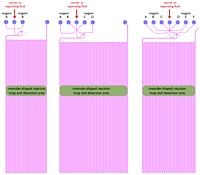Artificial containers such as droplets and vesicles in microfluidic environments represent an important area of research in downscaling combinatorial chemistry but we have proposed that they can also assist to
engineer artificial [1] and minimal [2] cells.
Chemical Microprocessors - ChµPs provide dynamic soft-walled microchemistry, replacing conventionally test tubes or
microwells by active dynamically controlled and even self-assembling microcontainers.
Droplets formed within microfluidic channels can serve as microreactors.
We proposed a wide range of microfluidic systems for droplet generation and/or passive mixing coupled with meander-shaped reaction channels within the detection area to observe the reaction kinetic of chemical reactions. An example is shown in the left figure.
Furthermore, we analyzed the integration of digital microfluidics using immiscible fluids in closed channels, for droplet generation, fusion and transport, extending previous work [3] to integrate continuous droplet generation and autonomously regulated serial droplet fusion [4]. Microfluidic creation and manipulation of vesicle structures has been demonstrated [5] as well as the encapsulation of beads, proteins and cells with the aid of microfluidics [6].
REFERENCES
[1] Rasmussen, S., et al. "Bridging nonliving and living matter." Artificial Life 2003, 9: p. 269. Rasmussen, S., et al. "Transitions from Nonliving to Living Matter." Science 2004, 303, 963-965.
[2] Noireaux, V. and A. Libchaber "A vesicle bioreactor as a step toward an artificial cell assembly" PNAS 2004, 101(51): 17669-17674.
[3] Tan, Y.-C., et al. "Design of microfluidic channel geometries for the control of droplet volume, chemical concentration, and sorting." LabChip 2004, 4: 292-298. Song et al. "Reactions in Droplets in Microfluidic Channels." Angew. Chem. Int. Ed. 2006, 45, 7336 – 7356.
[4] Wagler, P.F., et al. "Dynamical multiphase structures in the microsystem approach to artificial cells" in The Ninth International Conference on Miniaturized Systems for Chemistry and Life Sciences (μTAS), Boston, 2005, 1134-1136.
[5] Dittrich, P.S., et al. On-chip extrusion of lipid vesicles and tubes through microsized apertures. LabChip 2006 6: 488-493. Carlo, D.D., et al. "On-chip cell lysis by local hydroxide generation" LabChip 2005 5:171–178. Tan, Y.-C., et al. "Controlled Microfluidic Encapsulation of Cells, Proteins, and Microbeads in Lipids" Vesicles Journal of the American Chemical Society 2006, 128: 5656-5658.
[6] Tan et al. "Controlled Microfluidic Encapsulation of Cells, Proteins, and Microbeads in Lipid Vesicles." JACS 2006, 128, 5656-5658.







